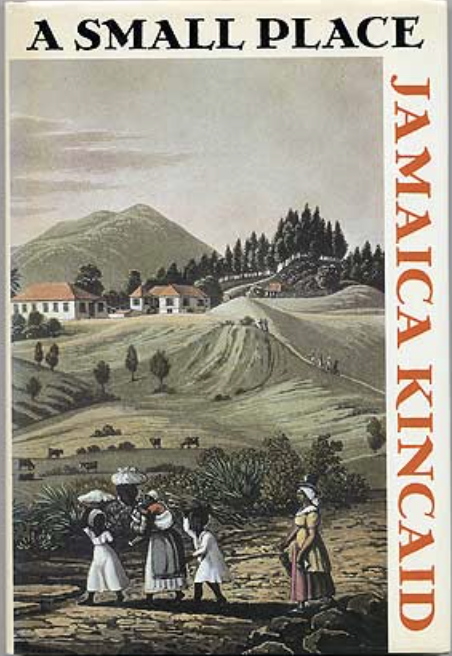by JAMES MANIGAULT-BRYANT

I periodically return to Jamaica Kincaid’s A Small Place because of its elegant analysis of postcolonial Antigua, a 100-square-mile island in the Eastern Caribbean.1 Although the text was published over thirty years ago, Kincaid’s richly textured and elaborately layered ethnographic account of her homeland remains vital for understanding Antigua, as well as the Caribbean’s other islands, even as the region endures climate catastrophes and a global pandemic. The power of A Small Place lies in how it reimagines Antigua’s enmeshment in the colonial sphere as a New World African myth, effectively conjuring anew the island’s genesis.
Colonized by Britain in the 17th century, Antigua was an enclave of sugar plantations farmed by generations of enslaved Africans. When the plantation economy declined in the mid-twentieth century, the island, like many in the Caribbean, was transformed into a desired tourist location because of its beautiful topography of breathtaking sunsets, deep blue seawater, and ivory-colored sands. A Small Place frustrates this desire for fantasy by lyrically contextualizing the island’s exquisiteness in the aftermath of European colonialism. A slim volume of about eighty pages, the text reads more like a long essay than a book; it does not have defined, numbered chapters, but is segmented into four sections separated by historical drawings of early, colonial Antigua. After it was published in 1988, the text was banned in Antigua until V. C. Bird’s presidential administration ended in 1994. Kincaid, fearing for her safety, did not return to her homeland for years.

The book is a defense of Antigua, but it is misleading to believe that Kincaid wrote it on behalf of Antiguans. She was born and reared on Antigua, but she left her country for the United States as a teenager and did not return for two decades. A Small Place was written shortly after her homecoming in 1986. The narrative voice of the text sounds this transnational “dislocation”2—a kind of drifting in and out of different social positions that endows her with a nostalgic, but critical insight into her native land. Assuming this voice allows Kincaid to indict her Western reader—the white “tourist”—in the second person. See, for instance, here: “You see yourself taking a walk on that beach, you see yourself meeting new people… You see yourself eating some delicious, locally grown food. You see yourself, you see yourself…” (13). Her accusations of the white tourist, which are given throughout her narrative tour of Antigua, eventually leads island visitors to an uncomfortably naked encounter with themselves: “The thing you have always suspected about yourself the minute you become a tourist is true: A tourist is an ugly human being” who makes “a leap from being that nice blob just sitting like a boob in your amniotic sac of the modern experience to being a person visiting heaps of death and ruin and feeling alive and inspired at the sight of it” (17). The voice that brings tourists to self-realization of their wretchedness also resents their possession of the financial means to willingly leave the banality of modern life, enter and consume the manufactured island fantasy, and then return to their homes where they procure the economic means for a global mobility that Antiguans do not possess.
After undressing, with biting humor, the psychology of the tourist, Kincaid pivots to Antigua’s material conditions. Drawing from the same sensibility of dislocation, she describes a country that restricts its own citizens’ mobility—its inadequate system of waste disposal, its poorly paved roads, its deteriorating utility poles, its horrendous and untrustworthy medical care, and its dilapidated libraries. These symptoms of Antigua’s degraded infrastructure are abetted by an atrocious government that hides the country’s decay behind the tourist gaze. The gaze also veils other forms of state-sanctioned corruption: government officials who facilitate—through pricing and media—the purchases of cars instead of property because they own or have investments in car dealerships. These same ministers own telecommunications and electric services and initiate other businesses to procure government contracts, like hotel casinos that buttress the tourist industry. How the government acquires its funds is integral to its villainy. Officials turn a blind eye to foreign merchants and drug dealers who hide their money in Antiguan banks, while accepting donations from those same smugglers. Most of all, government administrators are residents of the U.S., which provide them means to facilitate and escape from their acts of corruption. Their misdeeds make them, in effect, Western tourists: “…having observed the event of tourism, they have absorbed it so completely that they have made the degradation and humiliation of their daily lives into their own tourist attraction” (68-69). Taken together, the colonial project that disfigures the island is no longer completely in the hands of British colonizers, but is reproduced by native Antiguans.
The subjection of its landscape and its citizens to the exploitative desires of the global tourist industry anchor Antigua in a colonial temporality, one in which tourists do not see Antigua’s corruption or its wider colonial history memorialized by the landmarks, holidays, and businesses named after Englishmen or that celebrate British royalty. And since there is no narrative recourse to reimagine itself beyond its history as a possession of empire, Antigua struggles to find a story that can help it make sense of its disorder, which is only exacerbated by its dilapidated library, a sign of its meager epistemic resources to combat a dominant imperial discourse. Its weakened archive restricts its capacity to venture into timescapes apart from those defined by the colonizers, and cripples the formation of new, imaginative ventures into self-understanding beyond the dispossession of empire.
But in drawing from her dislocation to chart the structural details of Antigua’s fall, Kincaid turns back the clock of the island’s story past her own biographical relationship to her homeland to arrive at the historical event of Columbus’s voyage to the New World. In fact, she concludes A Small Place at the island’s founding moment: “Again, Antigua is a small place, a small island,” she writes, “It is nine miles wide by twelve miles long. It was discovered by Christopher Columbus in 1493.”3 Columbus’s encounter with the West Indies, as Kincaid has claimed in her other writing, led him to imagine it, erased of its Native populations, as the “blankness of paradise” because it bestowed upon the region “a life, a reality, that it did not have before.”4 The dream of the region’s emptiness set the stage for Europeans to settle the land with enslaved African labor.
Kincaid has often examined this history of the New World in her reflections on gardens, perhaps the most visited topic in her essays. She is herself a gardener, but she is also a historian of plants who possesses a deep understanding of how particular species have reached certain parts of the world. Gardening is instructive for Kincaid because it is a space for expressing certain aspects of the self—frustration, joy, possession—as well as an arena for worldmaking, of cultivating or eliminating new life. Kincaid imbues the garden metaphor—also invoked by Alice Walker, Fred Moten, and Willie James Jennings among other Black diasporic writers—with the hemispheric meaning of The New World, a region cultivated, at least since the fifteenth century, with a social and natural order of non-human and human species of all kinds. For the African-descended who carry a consciousness of the dislocation induced by this strange global order, the New World was a garden in which we landed after a fall from the Eden of Africa. A Small Place is Kincaid working out the continuation of that ongoing modern myth, of how her homeland, once her Eden, was disfigured after her flight from it.5 The book evinces freedom to think anew about home, after the fall, to imbue it with a new time.
